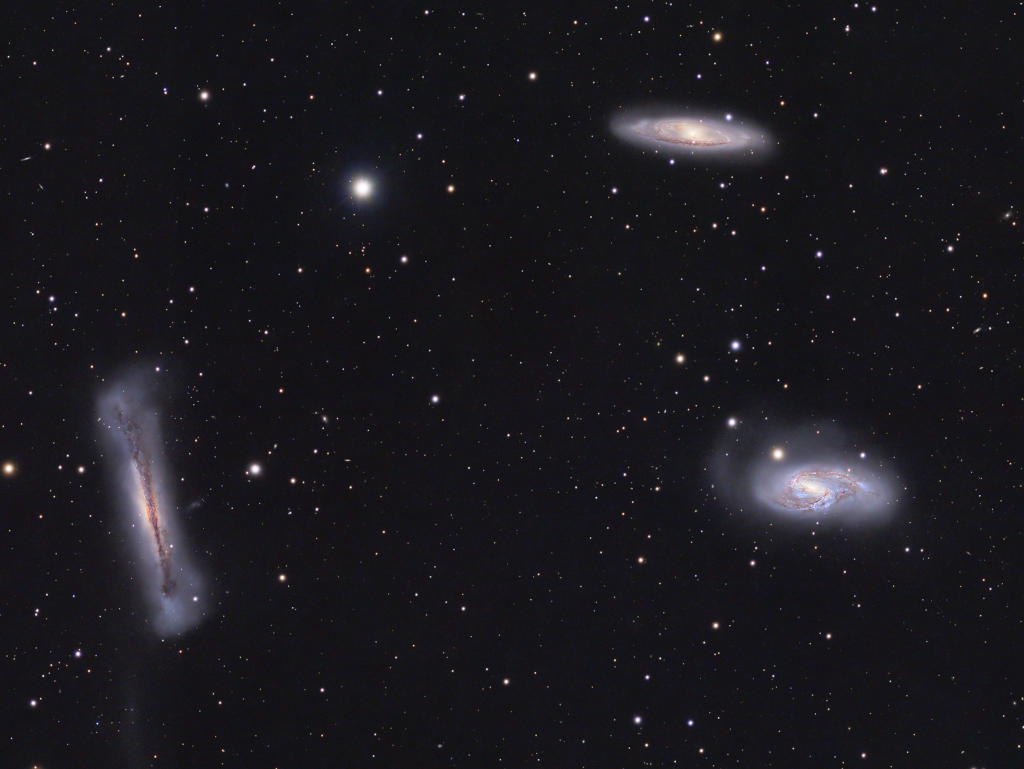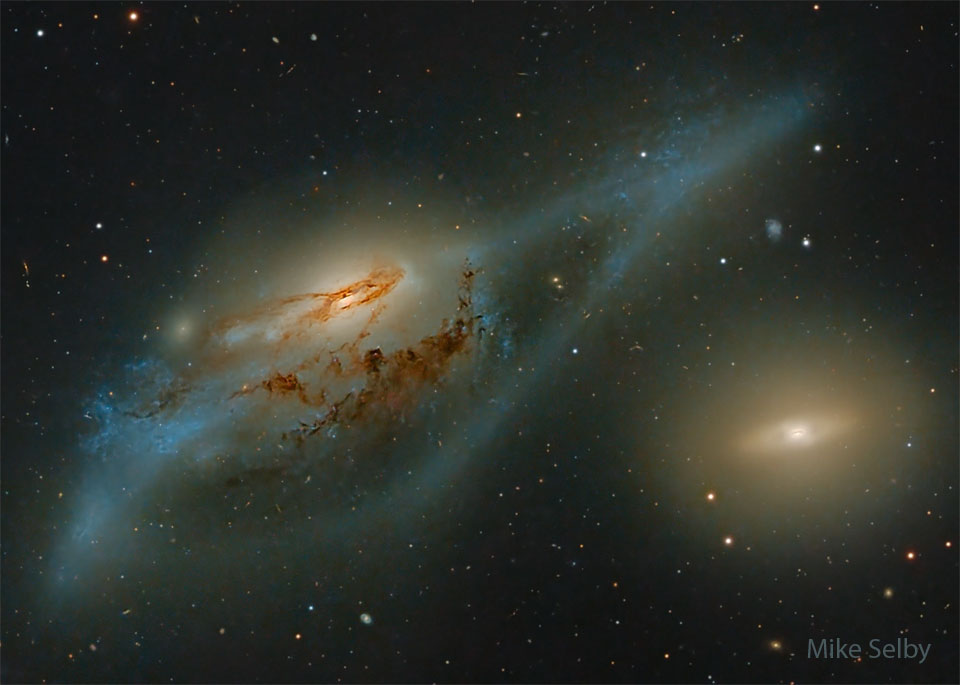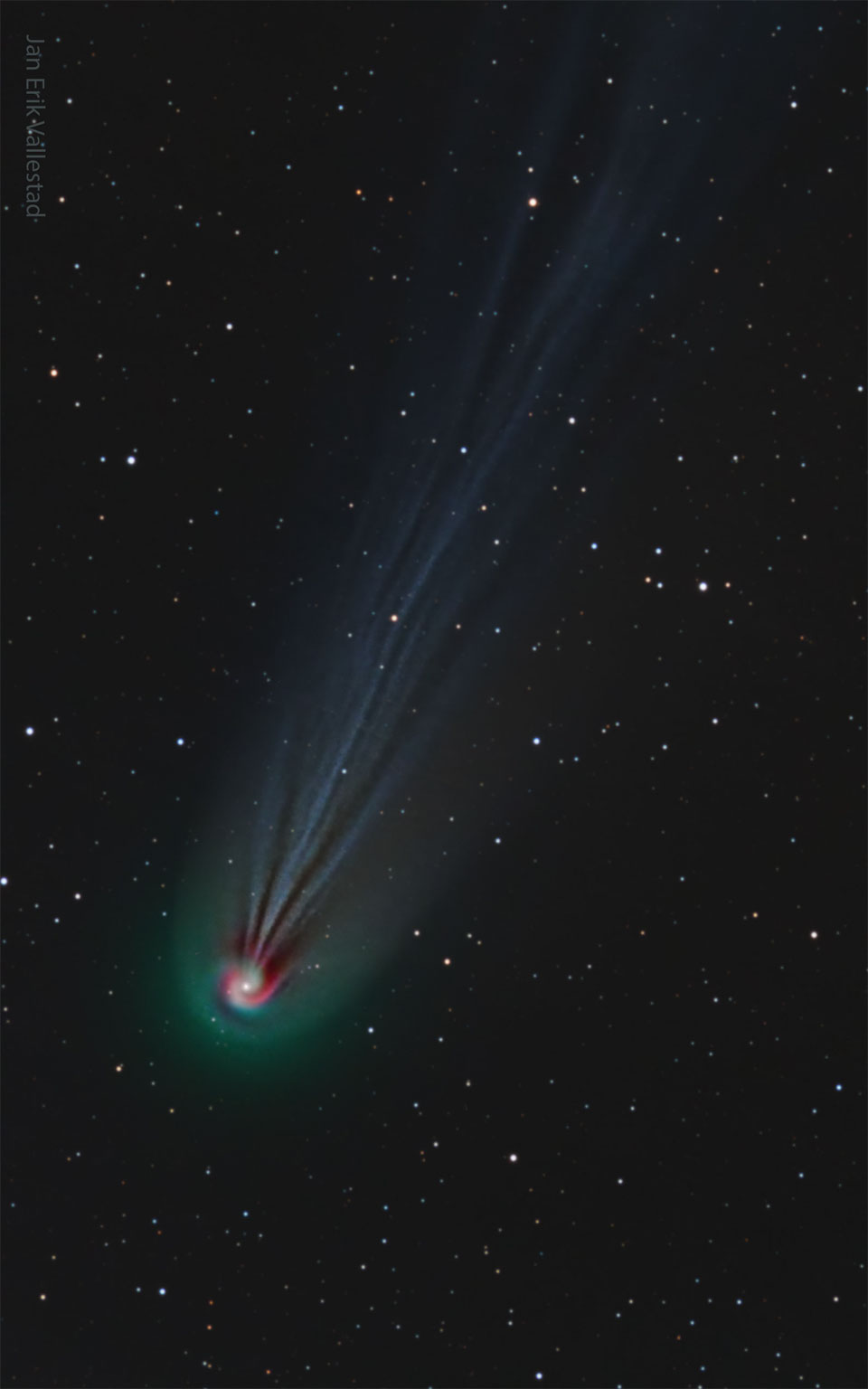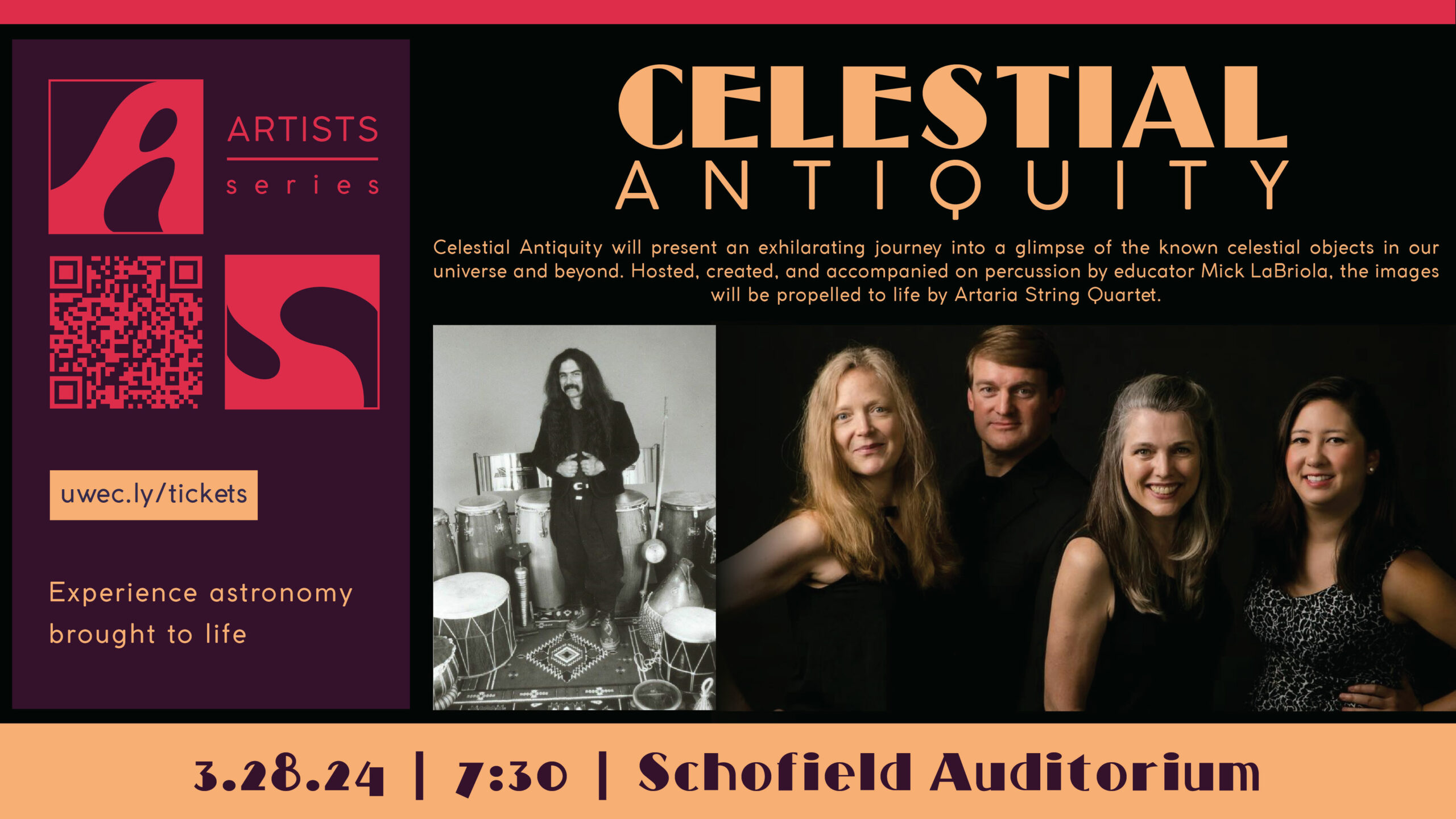Blog
the March equinox and the northern hemisphere spring. Famous as the Leo Triplet, the three magnificent galaxies found in the prominent constellation Leo gather here in one astronomical field of view. Crowd pleasers when imaged with even modest telescopes, they can be introduced individually as NGC 3628 (left), M66 (bottom right), and M65 (top). All three are large spiral galaxies but tend to look dissimilar, because their galactic disks are tilted at different angles to our line of sight. NGC 3628, also known as the Hamburger Galaxy, is temptingly seen edge-on, with obscuring dust lanes cutting across its puffy galactic plane. The disks of M66 and M65 are both inclined enough to show off their spiral structure. Gravitational interactions between galaxies in the group have left telltale signs, including the tidal tails and warped, inflated disk of NGC 3628 and the drawn out spiral arms of M66. This gorgeous view of the region spans over 1 degree (two full moons) on the sky in a frame that covers over half a million light-years at the trio’s estimated distance of 30 million light-years.

more...
David Perry Lindley (March 21, 1944 – March 3, 2023) was an American musician who founded the rock band El Rayo-X and worked with many other performers including Jackson Browne, Linda Ronstadt, Ry Cooder, Bonnie Raitt, Warren Zevon, Curtis Mayfield and Dolly Parton. He mastered such a wide variety of instruments that Acoustic Guitar magazine referred to him not as a multi-instrumentalist but instead as a “maxi-instrumentalist.” On stage, Lindley was known for wearing garishly colored polyester shirts with clashing pants, gaining the nickname the Prince of Polyester.
The majority of the instruments that Lindley played are string instruments, including violin, acoustic and electric guitar, upright and electric bass, banjo, mandolin, dobro, hardingfele, bouzouki, cittern, bağlama, gumbus, charango, cümbüş, oud and zither. He was the unparalleled master of the lap steel guitar in the rock music sphere, and an expert in Hawaiian-style slide guitar blues.
Lindley was a founding member of the 1960s psychedelic band Kaleidoscope and worked as musical director for several touring artists. He occasionally scored and composed music for film.
more...Solomon Vincent McDonald Burke (born James Solomon McDonald, March 21, 1940 – October 10, 2010) was an American singer who shaped the sound of rhythm and blues as one of the founding fathers of soul music in the 1960s. He has been called “a key transitional figure bridging R&B and soul”, and was known for his “prodigious output”.
He had a string of hits including “Cry to Me“, “If You Need Me“, “Got to Get You Off My Mind“, “Down in the Valley“, and “Everybody Needs Somebody to Love“. Burke was referred to honorificallyas “King Solomon”, the “King of Rock ‘n’ Soul”, “Bishop of Soul”, and the “Muhammad Ali of Soul”. Due to his minimal chart success in comparison to other soul music greats such as James Brown, Wilson Pickett, and Otis Redding, Burke has been described as the genre’s “most unfairly overlooked singer” of its golden age. Atlantic Records executive Jerry Wexler referred to Burke as “the greatest male soul singer of all time”.
Burke’s most famous recordings, which spanned five years in the early 1960s, bridged the gap between mainstream R&B and grittier R&B. Burke was “a singer whose smooth, powerful articulation and mingling of sacred and profane themes helped define soul music in the early 1960s.” He drew from his roots—gospel, jazz, country, and blues—as well as developing his own style at a time when R&B, and rock were both still in their infancy. Described as both “Rabelaisian“ and also as a “spiritual enigma”, “perhaps more than any other artist, the ample figure of Solomon Burke symbolized the ways that spirituality and commerce, ecstasy and entertainment, sex and salvation, individualism and brotherhood, could blend in the world of 1960s soul music.
more...Modest Petrovich Mussorgsky (Russian: Модест Петрович Мусоргский Modest Petrovich Musorgsky, IPA: [mɐˈdɛst pʲɪˈtrovʲɪtɕ ˈmusərkskʲɪj] 21 March [9 March] 1839 – 28 March 16 March] 1881) was a Russian composer, one of the group known as “The Five“. He was an innovator of Russian music in the Romantic period. He strove to achieve a uniquely Russian musical identity, often in deliberate defiance of the established conventions of Western music.
Many of his works were inspired by Russian history, Russian folklore, and other national themes. Such works include the opera Boris Godunov, the orchestral tone poem Night on Bald Mountain and the piano suite Pictures at an Exhibition.
For many years, Mussorgsky’s works were mainly known in versions revised or completed by other composers. Many of his most important compositions have posthumously come into their own in their original forms, and some of the original scores are now also available.
more...Otis Spann (March 21, 1924 or 1930 – April 24, 1970) was an American blues musician, whom many consider to be the leading postwar Chicago blues pianist.
Sources differ over Spann’s early years. Some state that he was born in Jackson, Mississippi, in 1930,but researchers Bob Eagle and Eric LeBlanc concluded on the basis of census records and other official information that he was born in 1924 in Belzoni, Mississippi.
Spann’s father was, according to some sources, a pianist called Friday Ford. His mother, Josephine Erby, was a guitarist who had worked with Memphis Minnie and Bessie Smith, and his stepfather, Frank Houston Spann, was a preacher and musician. One of five children, Spann began playing the piano at the age of seven, with some instruction from Friday Ford, Frank Spann, and Little Brother Montgomery.
more...Edward James “Son” House Jr. (March 21, 1902 – October 19, 1988) was an American Delta bluessinger and guitarist, noted for his highly emotional style of singing and slide guitar playing.
After years of hostility to secular music, as a preacher and for a few years also working as a church pastor, he turned to blues performance at the age of 25. He quickly developed a unique style by applying the rhythmic drive, vocal power and emotional intensity of his preaching to the newly learned idiom. In a short career interrupted by a spell in Parchman Farm penitentiary, he developed his musicianship to the point that Charley Patton, the foremost blues artist of the Mississippi Delta region, invited him to share engagements and to accompany him to a 1930 recording session for Paramount Records.
Issued at the start of the Great Depression, the records did not sell and did not lead to national recognition. Locally, House remained popular, and in the 1930s, together with Patton’s associate Willie Brown, he was the leading musician of Coahoma County. There he was a formative influence on Robert Johnson and Muddy Waters. In 1941 and 1942, House and the members of his band were recorded by Alan Lomax and John W. Work for the Library of Congress and Fisk University. The following year, he left the Delta for Rochester, New York, and gave up music.
In 1964, Alan Wilson, co-founder of the band Canned Heat, found Son and had him listen to his old recordings as Son had lost his way. He encouraged him to find his way back to the music and from this collaboration, Father of Folk Blues was born. Wilson even played second guitar on “Empire State Express” and the harp on ”Levee Camp Moan”. Son’s manager Dick Waterman said,” Al Wilson helped Son House find Son House”. He relearned his repertoire and established a career as an entertainer, performing for young, mostly white audiences in coffeehouses, at folk festivals and on concert tours during the American folk music revival, billed as a “folk blues” singer. He recorded several albums and some informally taped concerts have also been issued as albums. In 2017, his single “Preachin’ the Blues” was inducted into the Blues Hall of Fame.
more...Across the heart of the Virgo Galaxy Cluster lies a string of galaxies known as Markarian’s Chain. Prominent in Markarian’s Chain are these two interacting galaxies, NGC 4438 (left) and NGC 4435 – also known as The Eyes. About 50 million light-years away, the two galaxies appear to be about 100,000 light-years apart in this sharp close-up, but have likely approached to within an estimated 16,000 light-years of each other in their cosmic past. Gravitational tides from the close encounter have ripped away at their stars, gas, and dust. The more massive NGC 4438 managed to hold on to much of the material torn out in the collision, while material from the smaller NGC 4435 was more easily lost. The remarkably deep image of this crowded region of the universe also includes many more distant background galaxies.

Carl Frederick Kendall Palmer (born 20 March 1950) is an English drummer best known as a founding member of the supergroups Emerson, Lake & Palmer and Asia. He has toured with his own bands since 2001, including Palmer, the Carl Palmer Band, and currently, Carl Palmer’s ELP Legacy. He previously was a touring drummer for The Crazy World of Arthur Brown and a founding member of Atomic Rooster.
Palmer was inducted into the Modern Drummer Hall of Fame in 1989, and was awarded the Prog God Award at the 2017 Progressive Music Awards.
Palmer began taking drum lessons as a young boy. He took lessons with Britain’s best-known classical percussionist of the twentieth century, James Blades. His first band, formed with others from the Midlands area, was originally known as the King Bees, but changed its name to the Craig. In 1966, the band made its first record, “I Must Be Mad”, with flip side “Suspense”, produced by Larry Page. At this time, Palmer also did his first session work, playing on the song “Love Light” by the Chants, a group from Liverpool. Later in 1966, he was then invited to join Chris Farlowe and the Thunderbirds.
more...Harold Mabern Jr. (March 20, 1936 – September 17, 2019) was an American jazz pianist and composer, principally in the hard bop, post-bop, and soul jazz fields. He is described in The Penguin Guide to Jazz Recordings as “one of the great post-bop pianists”.
Mabern was born in Memphis, Tennessee on March 20, 1936. He initially started learning drums before switching to learning piano. He had access to a piano from his teens, after his father, who worked in a lumber yard, saved to buy him one. Mabern learned by watching and emulating pianists Charles Thomas and Phineas Newborn Jr. Mabern attended Douglass High School, before transferring to Manassas High School; he played with saxophonists Frank Strozier, George Coleman and trumpeter Booker Little at this time, but was most influenced by Newborn, Jr. In 1954, after graduating, Mabern moved to Chicago, intending to attend the American Conservatory of Music. He was unable to afford to attend music college because of a change in his parents’ financial circumstances, but had private lessons there for six months and developed his reading ability by playing with trombonist Morris Ellis’ big band. He also developed by listening to Ahmad Jamal and others in clubs, and “playing and practicing 12 hours a day” for the next five years, but he remained self-taught as a pianist. Mabern went on to play with Walter Perkins‘ MJT + 3 and others in Chicago.
Mabern learned orchestration techniques from bassist Bill Lee, and comping and chord voicing from pianists Chris Anderson and Billy Wallace.
more...Margaret Marian McPartland OBE Turner; 20 March 1918 – 20 August 2013), was an English–American jazz pianist, composer, and writer. She was the host of Marian McPartland’s Piano Jazz on National Public Radio from 1978 to 2011.
After her marriage to trumpeter Jimmy McPartland in February 1945, she resided in the United States when not travelling throughout the world to perform. In 1969, she founded Halcyon Records, a recording company that issued albums for 10 years. In 2000, she was named a National Endowment for the Arts Jazz Master. In 2004, she was given a Grammy Award for lifetime achievement. In 2007, she was inducted into the National Radio Hall of Fame. Although known mostly for jazz, she composed other types of music as well, performing her own symphonic work A Portrait of Rachel Carson with the University of South Carolina Symphony Orchestra in 2007. In 2010, she was named a member of the Order of the British Empire.
more...Sister Rosetta Tharpe (born Rosetta Nubin, March 20, 1915 – October 9, 1973) was an American singer, songwriter and guitarist. She gained popularity in the 1930s and 1940s with her gospel recordings, characterized by a unique mixture of spiritual lyrics and electric guitar. She was the first great recording star of gospel music, and was among the first gospel musicians to appeal to rhythm and blues and rock and rollaudiences, later being referred to as “the original soul sister” and “the Godmother of rock and roll “She influenced early rock-and-roll musicians including Little Richard, Johnny Cash, Carl Perkins, Chuck Berry, Elvis Presley, Jerry Lee Lewis, and also later guitarists, such as Eric Clapton.
Tharpe was a pioneer in her guitar technique; she was among the first popular recording artists to use heavy distortion on her electric guitar, opening the way to the rise of electric blues. Her guitar-playing technique had a profound influence on the development of British blues in the 1960s. Her European tour with Muddy Waters in 1964, with a stop in Manchester on May 7, is cited by British guitarists such as Eric Clapton, Jeff Beck, and Keith Richards.
Willing to cross the line between sacred and secular by performing her music of “light” in the “darkness” of nightclubs and concert halls with big bands behind her, Tharpe pushed spiritual music into the mainstream and helped pioneer the rise of pop-gospel, beginning in 1938 with the recording “Rock Me” and with her 1939 hit “This Train“. Her unique music left a lasting mark on more conventional gospel artists such as Ira Tucker Sr., of the Dixie Hummingbirds. While controversial among conservative religious groups due to her forays into the pop world, she never left gospel music.
Tharpe’s 1944 release “Down by the Riverside” was selected for the National Recording Registry of the U.S. Library of Congress in 2004, which noted that it “captures her spirited guitar playing and unique vocal style, demonstrating clearly her influence on early rhythm-and-blues performers” and cited her influence on “many gospel, jazz, and rock artists”. (“Down by the Riverside” was recorded by Tharpe on December 2, 1948, in New York City, and issued as Decca single 48106). Her 1945 hit “Strange Things Happening Every Day“, recorded in late 1944, featured Tharpe’s vocals and resonator guitar, with Sammy Price(piano), bass and drums. It was the first gospel record to cross over, hitting no. 2 on the Billboard “race records” chart, the term then used for what later became the R&B chart, in April 1945. The recording has been cited as a precursor of rock and roll, and alternatively has been called the first rock and roll record. In May 2018, Tharpe was posthumously inducted into the Rock and Roll Hall of Fame as an Early Influence.
more...A bright comet will be visible during next month’s total solar eclipse. This very unusual coincidence occurs because Comet 12P/Pons-Brooks‘s return to the inner Solar System places it by chance only 25 degrees away from the Sun during Earth’s April 8 total solar eclipse. Currently the comet is just on the edge of visibility to the unaided eye, best visible with binoculars in the early evening sky toward the constellation of the Fish (Pisces). Comet Pons-Brooks, though, is putting on quite a show for deep camera images even now. The featured image is a composite of three very specific colors, showing the comet’s ever-changing ion tail in light blue, its outer coma in green, and highlights some red-glowing gas around the coma in a spiral. The spiral is thought to be caused by gas being expelled by the slowly rotating nucleus of the giant iceberg comet. Although it is always difficult to predict the future brightness of comets, Comet Pons-Brook has been particularly prone to outbursts, making it even more difficult to predict how bright it will actually be as the Moon moves in front of the Sun on April 8.

more...
Clarence Henry II (born March 19, 1937), known as Clarence “Frogman” Henry, is an American rhythm and blues singer and pianist, best known for his hits “Ain’t Got No Home” (1956) and “(I Don’t Know Why) But I Do” (1961).
Clarence Henry was born in New Orleans, Louisiana, United States, in 1937, moving to the Algiersneighborhood in 1948. He started learning piano as a child, with Fats Domino and Professor Longhairbeing his main influences. When Henry played in talent shows, he dressed like Longhair and wore a wig with braids on both sides. He joined Bobby Mitchell & the Toppers in 1952, playing piano and trombone, before leaving when he graduated in 1955 to join saxophonist Eddie Smith’s band.
more...James Joseph “Buster“ Bennett (March 19, 1914 – July 3, 1980) was an American blues saxophonist and blues shouter. His nickname was “Leap Frog”. At various times in his career, he played the soprano saxophone, the alto, and the tenor. He was known for his gutbucket style on the saxophone. He also played the piano and the string bass professionally.
Bennett was born in Pensacola, Florida. By 1930 or so, he was working in Texas, but he spent most of his active career (1938 to 1954) in Chicago. He was employed as a session musician by Lester Melrose from 1938 to 1942; he played on recordings with Big Bill Broonzy, the Yas Yas Girl, Monkey Joe, and Washboard Sam.
more...More Posts
- Fats Domino Day
- World Music with Spanglish Fly
- Daily Roots with Hot Rod All Stars
- Echos of Freedom by MLK
- The Cosmos with NGC 3372
- George Harrison Day
- Hal Blaine Day
- Rene Thomas Day
- World Music with Michael Rooney and June McCormack
- Daily Roots with Joe Mansano
- Echos of Freedom by Edwin Grant Conklin
- The Cosmos with NGC 1316
- Nicky Hopkins Day
- David Fathead Newman Day
- World Music with M’Toro Chamou
- Daily Roots with the Cimarons
- Echos of Freedom by Rosario Castellanos
- The Cosmos with M33
- Johnny Winter Day
- Josiah “Cie” Frazier Day
